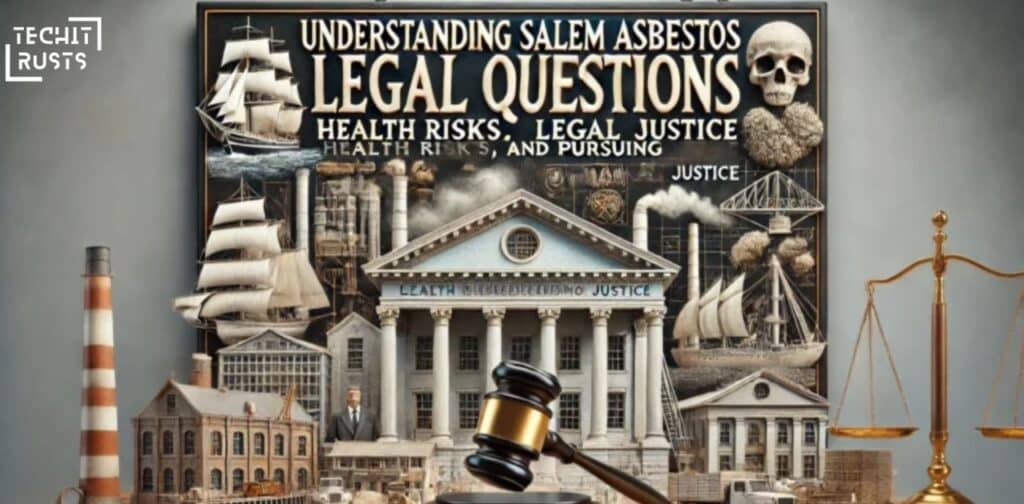Asbestos, once hailed for its fire-resistant properties, has left a devastating legacy. Exposure to this hazardous material can lead to serious health complications, such as mesothelioma, asbestosis, and lung cancer. For those in Springfield dealing with asbestos exposure, legal questions inevitably arise regarding their rights, how to seek compensation, and the process for filing lawsuits.
This comprehensive guide will address every Springfield asbestos legal question in detail, offering you the information you need to protect yourself and seek justice.
Introduction to the Springfield Asbestos Legal Question
The Springfield asbestos legal question covers a wide array of issues, ranging from employer liability to compensation claims. In the past, asbestos was commonly used in construction, shipbuilding, and many other industries. However, when asbestos fibers are disturbed and inhaled, they can become lodged in the lungs, leading to serious, sometimes fatal, diseases.
Despite asbestos being banned in many industries, exposure continues to affect Springfield residents due to aging buildings and materials that contain the substance. Understanding your legal options is essential if you or a loved one has been diagnosed with an asbestos-related disease.
Key Legal Concepts and Definitions
Before diving into the complexities of the Springfield asbestos legal question, it’s important to familiarize yourself with some of the key legal terms related to asbestos exposure.
- Asbestos Exposure: Contact with asbestos fibers, typically through inhalation or ingestion. This exposure can occur at home, in the workplace, or through secondary exposure (e.g., family members exposed to asbestos on a worker’s clothing).
- Mesothelioma: A rare form of cancer that affects the lining of the lungs, abdomen, or heart. It is almost exclusively caused by asbestos exposure.
- Negligence: A failure to act with the level of care that someone of ordinary prudence would have exercised under the same circumstances. Negligence in asbestos cases often involves employers or manufacturers who knew of the risks but failed to warn or protect workers.
- Liability: Legal responsibility for harm caused to another person. In asbestos cases, manufacturers, employers, or property owners may be liable for exposing people to harmful asbestos.
- Personal Injury Lawsuits: Legal cases filed by individuals who have been injured due to another party’s negligence or wrongful actions. In asbestos cases, personal injury lawsuits are often filed by those diagnosed with mesothelioma or other asbestos-related diseases.
This section provides the foundational knowledge to understand the legal landscape surrounding asbestos litigation in Springfield. Let’s explore the common challenges faced when dealing with an asbestos-related lawsuit.
Common Legal Challenges in Asbestos Cases

Filing a lawsuit related to asbestos exposure is not always straightforward. Victims often face several legal obstacles that can make it difficult to win compensation. Understanding these challenges is vital when addressing any Springfield asbestos legal question.
Proving Asbestos Exposure
One of the most significant challenges in asbestos litigation is proving exposure. Asbestos-related diseases like mesothelioma can take decades to develop after initial exposure. This long latency period makes it difficult to trace when and where exposure occurred. Many victims were exposed to asbestos 20 to 50 years ago, making it a daunting task to gather evidence.
Often, the workplace is the primary location of exposure. If you worked in industries like construction, shipbuilding, or manufacturing, it’s crucial to trace your employment history to identify periods when you were exposed to asbestos. Documenting specific products or materials that contained asbestos will strengthen your case.
Employer and Manufacturer Liability
Determining liability is another significant challenge. In asbestos cases, multiple parties could be held responsible for exposure. Your employer may have known that asbestos was present but failed to provide adequate safety measures. Alternatively, manufacturers that produced asbestos-containing products may be liable if they did not warn consumers about the risks associated with their products.
In Springfield, many older buildings and facilities still contain asbestos in insulation, roofing materials, or floor tiles. If you were exposed to asbestos in a public building or through a contractor, you might be able to hold the property owner or contractor responsible.
Statute of Limitations
The statute of limitations is a legal deadline that restricts the amount of time you have to file a lawsuit. In Springfield, as in many places, the statute of limitations for filing an asbestos-related lawsuit typically begins when the illness is diagnosed, not when the exposure occurred. However, if too much time passes, you could lose your right to seek compensation.
It’s critical to consult an attorney as soon as you are diagnosed with an asbestos-related illness. Even if you believe the exposure happened decades ago, you may still be within the statute of limitations if your diagnosis is recent.
| Legal Challenges | Impact on Asbestos Cases |
|---|---|
| Proving Exposure | Requires detailed records of when and where exposure occurred. |
| Employer Liability | Holding the correct party accountable can be difficult. |
| Statute of Limitations | Missing the deadline for filing could eliminate your chances of compensation. |
Navigating these legal challenges is where an experienced asbestos attorney can make a significant difference. They can help gather the necessary evidence, determine liability, and ensure you meet critical deadlines.
Steps to Address a Springfield Asbestos Legal Question
If you or a loved one has been diagnosed with an asbestos-related illness, the steps you take in addressing the Springfield asbestos legal question are crucial. Taking the right steps early on can improve your chances of a successful claim and ensure you receive compensation for medical expenses, lost wages, and other damages.
Step 1: Identify Potential Asbestos Exposure
The first step is to identify when and where you were exposed to asbestos. As mentioned earlier, this may be at your workplace, in your home, or through secondary exposure.
Start by reviewing your employment history. If you worked in any high-risk industries, make note of the locations, employers, and job duties you had at the time. Your attorney will likely need this information to establish when and where you were exposed.
If your exposure occurred in a non-workplace setting, such as in your home, gathering evidence may involve identifying old building materials or home improvement projects where asbestos was used.
Step 2: Obtain a Medical Diagnosis
A formal diagnosis from a qualified medical professional is essential to your case. Mesothelioma, asbestosis, and other asbestos-related illnesses require a specific set of diagnostic tests, including imaging scans and biopsies. A medical diagnosis not only confirms the illness but also links it to asbestos exposure, which is critical for your legal claim.
Keep copies of all medical records, including test results, treatments, and doctors’ notes, as they will serve as key pieces of evidence in your lawsuit.
Step 3: Consult an Attorney Experienced in Asbestos Litigation
The complexities of asbestos litigation make it essential to consult with an attorney who specializes in this area. Not all personal injury lawyers have experience handling Springfield asbestos legal questions, so it’s important to find one with a proven track record in asbestos cases.
An experienced attorney will guide you through the process, help you understand your legal rights, and develop a strong case to pursue compensation options. They will also be familiar with local and federal asbestos regulations that may affect your case.
Step 4: Gather Evidence
Assembling the right evidence is critical to proving your claim. You will need to provide documentation of both your asbestos exposure and your resulting illness. This includes:
- Medical records that detail your diagnosis and treatment.
- Employment history that shows where you may have been exposed to asbestos.
- Witness testimony from coworkers or experts who can testify to the presence of asbestos in your workplace.
- Product identification to show which asbestos-containing materials or products you came into contact with.
Step 5: File Your Claim
Once you and your attorney have gathered the necessary evidence, the next step is to file your lawsuit. Filing a claim formally begins the legal process, and it can lead to either a settlement or a trial. Your attorney will handle all aspects of filing and ensure that all legal documents are submitted on time.
Filing a lawsuit may seem daunting, but with the right legal representation, you can focus on your health while your attorney fights for the compensation you deserve.
| Step | Action Taken |
|---|---|
| Identify Exposure | Review employment and home history to determine asbestos exposure points. |
| Obtain Diagnosis | Secure a formal medical diagnosis linking asbestos exposure to your illness. |
| Hire an Attorney | Seek legal counsel with experience in asbestos litigation. |
| Gather Evidence | Collect medical records, employment history, and product information. |
| File a Claim | Initiate the legal process to pursue compensation. |
Understanding Compensation Options
Victims of asbestos exposure in Springfield have several potential compensation options. Understanding the different forms of compensation available to you is critical in ensuring that you receive the full amount you’re entitled to.
Types of Compensation
Victims of asbestos-related diseases often qualify for two main types of compensation: economic and non-economic damages.
- Economic Damages: These are tangible, measurable losses directly tied to your illness. Economic damages typically include:
- Medical expenses, such as doctor visits, surgeries, medications, and long-term care.
- Lost wages and diminished earning capacity if your illness prevents you from working.
- Travel expenses for treatment and consultations.
- Funeral costs, in the event of a wrongful death lawsuit.
- Non-Economic Damages: These compensate for the intangible losses suffered as a result of asbestos exposure. They include:
- Pain and suffering.
- Emotional distress.
- Loss of companionship, if a family member has passed away due to an asbestos-related illness.
Settlements vs. Trials
In most asbestos cases, defendants prefer to settle out of court rather than go through a lengthy and expensive trial. Settlements often provide faster compensation to the victims and their families. However, the amount offered in a settlement may be lower than what could be awarded at trial.
| Option | Description |
|---|---|
| Settlement | A legal agreement to resolve the case without going to trial, typically involving a monetary payout. |
| Trial | A courtroom process where a judge or jury determines the outcome. Trials can result in higher compensation but take longer and are riskier. |
Choosing between a settlement and a trial will depend on the strength of your case, the defendant’s offer, and your attorney’s advice. Both options have their benefits, but a knowledgeable lawyer can help you decide which is best for your circumstances.
Asbestos Trust Funds
Asbestos trust funds are established by bankrupt companies that were once major producers or users of asbestos-containing products. These companies were required to set aside money to compensate current and future asbestos victims. Filing a claim with an asbestos trust fund is an alternative to filing a lawsuit against a company.
The Role of Evidence in Asbestos Cases

Strong evidence is the backbone of any successful asbestos case. Without it, proving asbestos exposure and linking it to your illness is nearly impossible. Understanding the types of evidence required and how to gather it is key to answering any Springfield asbestos legal question.
Medical Evidence
The most critical piece of evidence in any asbestos case is your medical diagnosis. This must show that you have an asbestos-related illness, such as mesothelioma, lung cancer, or asbestosis. Your medical records, including imaging scans, biopsies, and doctors’ notes, should clearly link your illness to asbestos exposure.
Employment Records
Proving that you were exposed to asbestos often requires detailed employment records. This includes records from past employers, union membership documents, and any other paperwork that shows where and when you worked in industries that used asbestos.
If your employer is no longer in business, your attorney can help track down old records, witness testimony, or expert analysis to prove your case.
Witness Testimony
Testimony from coworkers, supervisors, or industry experts can be invaluable in proving asbestos exposure. These witnesses can provide firsthand accounts of the presence of asbestos in your workplace, the safety measures (or lack thereof) in place, and how workers were exposed.
| Evidence Type | Importance |
|---|---|
| Medical Evidence | Links your illness to asbestos exposure. |
| Employment Records | Proves when and where you were exposed. |
| Witness Testimony | Supports your account of exposure. |
Expert Witnesses
In many asbestos cases, expert witnesses are brought in to provide specialized knowledge about asbestos-related diseases and workplace exposure. These experts can testify about how asbestos was used in specific industries or how exposure leads to diseases like mesothelioma.
How to Choose the Right Attorney

Choosing the right attorney is one of the most important steps you can take when dealing with a Springfield asbestos legal question. Not all lawyers are equipped to handle the complexities of asbestos litigation, so finding an experienced attorney who specializes in these cases is essential.
Experience Matters
When looking for an attorney, focus on their experience with asbestos exposure cases. Ask about their track record of winning compensation for clients, and find out how many asbestos cases they’ve handled. An experienced lawyer will understand the intricacies of asbestos law, the types of evidence needed, and the best legal strategies for winning your case.
Local Knowledge
Local laws and regulations can significantly impact your case, so finding an attorney who is familiar with Springfield’s legal landscape is a major advantage. They will be better equipped to navigate state-specific challenges and may have established relationships with local courts and expert witnesses.
Client Testimonials
Reading client testimonials can provide insight into an attorney’s success rate and how well they work with clients. Look for reviews from people who have filed asbestos-related lawsuits, and see if they were satisfied with the level of communication, legal expertise, and outcome.
Legal Fees
Asbestos cases can be costly to litigate, but most attorneys take these cases on a contingency fee basis. This means you won’t have to pay any legal fees upfront, and your attorney will only get paid if they win your case. Typically, the attorney will take a percentage of your settlement or court award as their fee.
| Criteria for Choosing an Attorney | Why It Matters |
|---|---|
| Experience in Asbestos Cases | Ensures your lawyer knows how to navigate asbestos law. |
| Local Knowledge | Helps navigate Springfield-specific regulations. |
| Client Testimonials | Gives you insight into the lawyer’s reputation. |
| Legal Fees | Makes litigation affordable with a contingency fee arrangement. |
Impact of Local Regulations on Asbestos Cases
Local regulations play a significant role in any Springfield asbestos legal question. Understanding the laws governing asbestos use, removal, and litigation in Springfield will help you make informed decisions about your case.
Springfield Building Codes and Asbestos Removal
In Springfield, older buildings often contain asbestos in insulation, roofing, and flooring materials. The city has strict regulations about asbestos removal and disposal to minimize the risk of exposure to the public. If you were exposed to asbestos during a home renovation, construction project, or public building, understanding these regulations is key.

For instance, Springfield requires that any building constructed before 1980 be tested for asbestos before renovation or demolition can begin. Failure to do so can result in penalties for the property owner or contractor, which may strengthen your legal case.
Occupational Safety and Health Regulations
In addition to local building codes, occupational safety regulations play a critical role in preventing asbestos exposure. The Occupational Safety and Health Administration (OSHA) sets standards for how employers must protect workers from asbestos exposure.
If your employer failed to follow OSHA guidelines—such as providing proper safety equipment or conducting regular air quality tests—you may have a strong case for negligence.
| Local Regulation | Impact on Asbestos Cases |
|---|---|
| Building Codes | Non-compliance can strengthen your legal claim. |
| OSHA Guidelines | Failure to follow guidelines could lead to employer liability. |
How Recent Legislation Affects Asbestos Lawsuits
Asbestos laws are constantly evolving, and recent legislation can have a significant impact on your case. Understanding the latest legal developments can help you make informed decisions about your lawsuit.
Federal vs. State Laws
Federal laws, such as the Clean Air Act, regulate the use and disposal of asbestos across the country. However, each state, including Missouri, has its own specific laws that govern asbestos litigation. For example, Missouri has a two-year statute of limitations for personal injury claims related to asbestos exposure, which differs from other states.
Changes to Asbestos Trust Fund Legislation
Asbestos trust funds are designed to compensate victims of asbestos exposure whose employers or product manufacturers have gone bankrupt. However, new legislation is periodically introduced that may limit or expand access to these funds.
For instance, recent laws have been proposed to make it more difficult to access asbestos trust funds by requiring victims to provide more detailed evidence of their exposure and illness. These changes could affect how much compensation you’re eligible for and how long it takes to receive payment.
Settlement vs. Trial: Evaluating Your Options
One of the most important decisions you will make in your asbestos case is whether to accept a settlement or go to trial. Each option has its pros and cons, and the best choice will depend on your circumstances.
Benefits of Settling
Most asbestos cases are settled out of court, meaning that the plaintiff agrees to accept a certain amount of compensation in exchange for dropping the lawsuit. Settlements are often faster and less stressful than trials, allowing victims to receive compensation more quickly.
Risks of Going to Trial
While going to trial can result in a higher payout, it’s also riskier. Trials can take months or even years to resolve, and there’s no guarantee that you’ll win. If you lose, you won’t receive any compensation, and you may be responsible for court fees.
Your attorney will help you weigh the pros and cons of settling versus going to trial. They will evaluate the strength of your case, the defendant’s offer, and your financial needs to help you make the best decision.
| Option | Pros | Cons |
|---|---|---|
| Settlement | Faster, less stressful, guaranteed payout. | May result in lower compensation. |
| Trial | Potential for a higher payout. | Takes longer, riskier. |
Statutes of Limitation and Their Effect on Your Case
The statute of limitations is a critical legal concept that can determine whether or not you can file a lawsuit. In Springfield, the statute of limitations for filing an asbestos-related claim typically begins when you are diagnosed with an illness caused by asbestos exposure.
Delayed Diagnosis
Asbestos-related diseases often have a long latency period, meaning symptoms may not appear until 20 to 50 years after exposure. Fortunately, the statute of limitations takes this into account. Even if you were exposed to asbestos decades ago, you can still file a claim if your illness was diagnosed within the past two years.
Common Defenses in Asbestos Cases
Defendants in asbestos exposure cases often use a variety of defenses to avoid liability. Understanding these can help you and your attorney craft a strong legal strategy to counter them.
Assumption of Risk
One common defense is that the plaintiff assumed the risk of asbestos exposure by working in a high-risk industry. Employers may argue that the plaintiff was aware of the dangers but chose to work in that environment anyway.
Contributory Negligence
Another defense is that the plaintiff was partially responsible for their asbestos exposure, either by failing to follow safety procedures or by working with asbestos-containing materials outside of the workplace.
Third-Party Liability
Defendants may also try to shift the blame onto another party, such as a supplier or contractor, to avoid liability. In these cases, your attorney may need to investigate other potential defendants to ensure everyone responsible is held accountable.
| Defense | Description |
|---|---|
| Assumption of Risk | Argues the plaintiff knew the risks but accepted them anyway. |
| Contributory Negligence | Claims the plaintiff was partially responsible for their exposure. |
| Third-Party Liability | Shifts the blame to another party, such as a supplier or contractor. |
Conclusion
Addressing the Springfield asbestos legal question involves navigating a complex legal landscape. From proving asbestos exposure to determining liability, every step of the process requires careful attention to detail.
Whether you’re dealing with a personal injury lawsuit, exploring compensation options, or filing a claim with an asbestos trust fund, having an experienced attorney by your side is essential. They can guide you through the process, protect your rights, and help you secure the compensation you deserve for your illness.
Remember, time is of the essence. If you or a loved one has been diagnosed with an asbestos-related disease, consult with an attorney as soon as possible to explore your legal options.

Ashi is the site admin for “techitrusts.com” and specializes in writing within the journal category. If you need more detailed information about his background or work, feel free to ask!